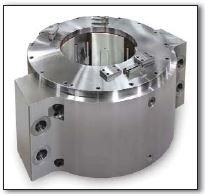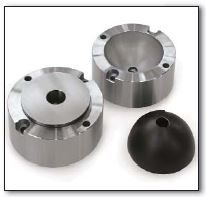Reducing Spiral Vibration on a Genset
TILTING PAD RADIAL BEARINGS SHIFT CRITICAL SPEEDS OF THE SLIP RING SHAFT WELL ABOVE THE RATED SPEED
An Alstom 450MVA hydrogen-cooled generator operating at 3,600 rev/min and equipped with a brush gear unit showed spiral vibration with a forward rotating unbalance vector. Spiral vibration, also known as the Newkirk effect, can be observed on various types of turbomachinery and is caused by a vibration-induced hot spot on the shaft surface generated by friction. During performance validation, the relative shaft vibration at the generator, non-driven end bearing was measured to be close to trip level and therefore a root cause analysis was initiated by Alstom to understand and solve the problem. Subsequent running tests on the generator test stand at Alstom’s factory confirmed that the carbon brushes sliding on the slip rings were the cause of the hot spot.
Potential modifications were studied by Alstom using hot spot stability analysis with a rotor dynamic model of the generator rotor and bearing supports. Based on the calculated results, a modification of the generator shaft line was implemented using tilting pad radial bearings at the generator non-drive end and exciter end locations to shift the slip ring shaft critical speeds well above the rated speed.
The first set of these bearings was ordered in January 2003. The general requirement was for a drop in replacement retrofit with no modifications to the existing bearing pedestals or changes in the boundary conditions permitted. Shaft diameters at the generator non-drive end and exciter end bearings were 400mm and 250mm respectively.
In terms of performance, the new bearings were required to have maximized stiffness coefficients, in the direct coupled horizontal plane. Design shaft speed was 3,600 rev/min with radial bearing loads of 22 m.t. and 3 m.t. for the generator non-drive end and exciter end bearings, respectively. Lubricant was ISO VG 46 at a design inlet temperature of 45°C.
To maximize the oil film stiffness coefficients, both designs used an offset pivot and the assembled bearing clearance was also reduced below the normal range. The 400mm bearing was manufactured using a ball-and-socket pivot to maximize pivot stiffness and accommodate potential misalignment at the generator non-drive end.
Double insulation was required on both bearing designs to prevent grounding of shaft currents via the bearings. This system also allows direct measurement of the electrical resistance of each insulating layer when the bearings are assembled on the shaft. The design also required hydrostatic jacking and provision for instrumentation to match the original equipment fittings.
The radial space constraints within the existing bearing pedestals on this application posed an immediate challenge with respect to achieving acceptable load support and oil inlet flow velocities within the bearing housing. Because of this, the bearing design went through several iterations, resulting in the redesign and optimization of the original double insulation radial adjustment support system, which is mounted on the outside of the bearing housing.

Figure 1: Waukesha Bearings’ Maxalign Tilting Pad Radial Bearing with “directed lubrication.” The bearing is one of a set supplied on a large 50Hz steam turbine retrofit project. Design includes offset pivot and CuCr pads to reduce pad temperatures, and hydrostatic jacking to protect bearing and reduce friction during machine start up[/caption]
The design principles of the ball and socket pivot have over 25 years of operating experience (Figure 1) on large rotating equipment, including turbogenerators, steam turbines, gas turbines and synchronous clutches, with the first application dating back to 1980 on a 130 MW generator. The design was developed to meet the requirements of maximum pivot stiffness for bearing dynamics and dynamic alignment capability (axial and skew) to accommodate changes in shaft alignment caused by mechanical loading and thermal effects, which can be more significant on larger machines.
This approach avoids the potential problems of pivot wear and fretting, which can be particularly troublesome on larger bearings. The ball and sockets are set in the housing at the supply stage, and intended to remain undisturbed for the life of the bearing. Within specified amounts, and due to the separate pad support arrangement, the bearing clearance can be reset to allow for damaged and reground shafts (Figure 2).

Figure 2: WB’s Maxalign Ball and Socket pivot accommodates changes in shaft alignment[/caption]
There are now more than 13 generator sets in operation in the U.S. In total, these units have accumulated over 600,000 operating hours with maximum vibration levels within ISO limits.